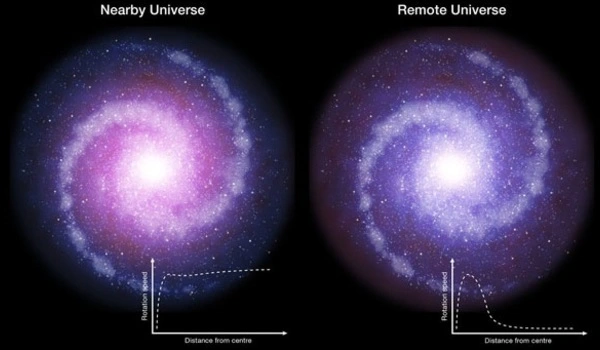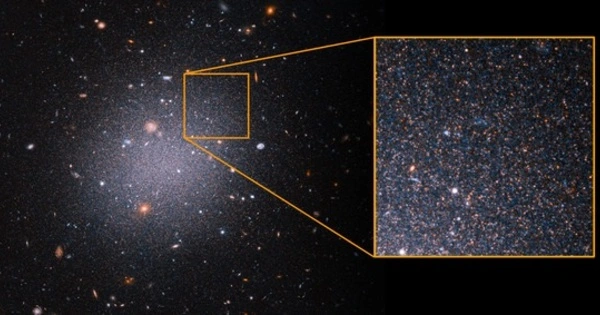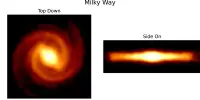Astrophysicists report that when tiny galaxies collide with larger ones, the larger galaxies can strip the smaller galaxies of their dark matter – matter that we can’t see directly but that astrophysicists believe must exist because they couldn’t explain things like the motions of a galaxy’s stars without its gravitational effects.
An international team led by astrophysicists from the University of California, Irvine, and Pomona College report in Nature Astronomy how, when tiny galaxies collide with larger ones, the larger galaxies can strip the smaller galaxies of their dark matter — matter that we can’t see directly but that astrophysicists believe must exist because they couldn’t explain things like the motions of a galaxy’s stars without its gravitational effects.
It’s a mechanism that has the potential to explain how galaxies might be able to exist without dark matter — something once thought impossible. It started in 2018 when astrophysicists Shany Danieli and Pieter van Dokkum of Princeton University and Yale University observed two galaxies that seemed to exist without most of their dark matter.
“We were expecting large fractions of dark matter,” said Danieli, who’s a co-author on the latest study. “It was quite surprising, and a lot of luck, honestly.”
The discovery of dark matter-free galaxies has concerned me. We have a successful model that has been created over decades of hard labor in which the majority of matter in the universe is dark. Nature could have been deceiving us.
James Bullock
The serendipitous discovery, which van Dokkum and Danieli reported on in a Nature study in 2018 and an Astrophysical Journal Letters paper in 2020, threw the galaxies-need-dark-matter paradigm into disarray, potentially upending what astrophysicists had come to consider as a mainstream explanation for how galaxies behave.
“It’s been recognized over the last 40 years that galaxies have dark matter,” said Jorge Moreno, an astronomy professor at Pomona College and the paper’s primary author. “Low-mass galaxies, in particular, have considerably greater dark matter fractions, making Danieli’s discovery all the more startling. For many of us, this meant that our existing understanding of how dark matter helps galaxies grow needed to be revised immediately.”
The researchers used computer models to mimic the evolution of a 60 million light-year-wide slice of the cosmos from just after the Big Bang to the present. The researchers discovered seven galaxies devoid of dark matter. They were stripped of most of their material after repeated collisions with neighboring galaxies 1,000 times more massive, leaving nothing but stars and some remnant dark matter.
“It was pure serendipity,” said Moreno. “The moment I made the first images, I shared them immediately with Danieli, and invited her to collaborate.”

According to Robert Feldmann, a researcher at the University of Zurich who constructed the new simulation, “our theoretical study implies that dark matter-deficient galaxies should be relatively prevalent, especially in the proximity of big galaxies.”
UCI’s James Bullock, an astrophysicist and expert on low-mass galaxies, described how he and the team didn’t build their model just to create galaxies without dark matter – something he says makes the model stronger because it wasn’t designed in any way to create the collisions that they eventually discovered. “We don’t assume interactions,” Bullock explained.
Confirming that galaxies lacking dark matter can be explained in a universe where there’s lots of dark matter is a sigh of relief for researchers like Bullock, whose career and everything he’s discovered therein hinges on dark matter being the thing that makes galaxies behave the way they do.
“The discovery of dark matter-free galaxies has concerned me,” Bullock stated. “We have a successful model that has been created over decades of hard labor in which the majority of matter in the universe is dark. Nature could have been deceiving us.”
However, according to Moreno, “you don’t have to abandon the traditional dark matter model.”
Moreno and his colleagues hope that now that astrophysicists understand how a galaxy loses its dark matter, the discoveries will inspire researchers who look at the night sky to look for real-world big galaxies that may be in the process of pulling dark matter away from smaller ones.
“It doesn’t mean this model is correct,” Bullock added. “A true test will be to observe if these objects exist with the frequency and general features predicted by us.”
Moreno, who has indigenous ancestors, was granted permission from Cherokee authorities to name the seven dark matter-free galaxies discovered in their simulations after the seven Cherokee clans: Bird, Blue, Deer, Long Hair, Paint, Wild Potato, and Wolf.
“I have a personal connection to these galaxies,” Moreno stated, adding that, much as the more massive galaxies took the smaller galaxies of their dark matter, “many indigenous people were stripped of our culture.” But our core has not changed, and we are still thriving.”
















